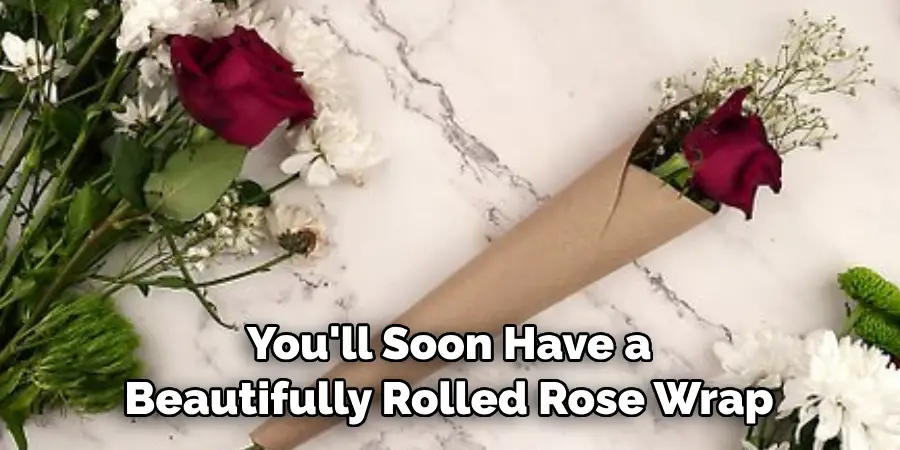Welcome! If you’ve ever wanted to learn the art of floral arranging and were intimidated by techniques like rose wrapping, you’ve come to the right place.
Rolling a rose wrap may seem daunting at first, but I’m here to tell you that with a bit of practice, anyone can master this beautiful floristry technique. In this post on how to roll a rose wrap, I’ll share step-by-step instructions on how to roll your very own rose wrap, along with some tips and tricks I’ve learned over the years working as a professional florist.

By the end, you’ll be wowing friends and family with your newfound floral skills and creating stunning arrangements worthy of any occasion. Let’s get started with the easy supplies you’ll need to get rolling!
10 Simple Step-by-step Guidelines on How to Roll a Rose Wrap
Step 1: Gather Your Supplies
To create a rose wrap, you’ll need a few basic items:
- A Fresh, Trimmed Rose Stem
- Floral Tape
- Scissors
- Ribbon (Optional)
Step 2: Prep Your Work Space
To ensure a smooth and efficient rolling process, make sure your work area is clean and well-lit. This will help you see each step clearly and avoid any mistakes. But don’t worry, even if you do make a mistake, floral tape is forgiving and can easily be repositioned. The beauty of this technique is that it’s forgiving and allows for a bit of artistic freedom. You can even mix and match different colors of roses for a unique look.

Step 3: Prepare Your Rose
Before you can start rolling your rose wrap, you’ll need to prep the rose itself. Start by removing any thorns or leaves from the stem, leaving only the main head of the rose intact. This will make it easier to work with and create a more polished look. It’s also a good idea to trim the stem to your desired length, making sure it’s not too long or too short for your chosen container.
Step 4: Cut a Piece of Floral Tape
Using your scissors, cut a piece of floral tape that is approximately six inches in length. This will provide enough room for you to comfortably work with while rolling the wrap. It’s essential to use floral tape for this technique as it has a slight adhesive quality that will help hold your rose wrap together. But don’t worry, it won’t harm the rose at all. It’s gentle and safe to use on even the most delicate flowers.
Step 5: Start Rolling
Place one end of the floral tape at the base of the rose head and begin rolling your stem in an upwards direction, slightly overlapping each roll as you go. You should aim for a diagonal pattern, creating a spiral effect as you wrap. Keep the tape taut but not too tight, as this can cause the stem to bend or break. It’s important to maintain a consistent angle as you wrap, so your rose wrap appears evenly rolled. This may take a little bit of practice, but don’t get discouraged if it’s not perfect the first time around.
Step 6: Continue Rolling
As you continue rolling, make sure to keep the stem straight and even, so your rose wrap doesn’t end up lopsided. If you do notice any unevenness, simply unroll and start again. Don’t worry; it takes a bit of practice to perfect the technique! But trust me, it’s worth the effort. You’ll soon have a beautifully rolled rose wrap that will make any flower arrangement look professionally done. It’s that simple!
Step 7: Secure the End
Once you’ve reached the desired length for your rose wrap, secure the end of the floral tape by pressing it down firmly onto the stem. You can also use a small piece of clear tape to hold it in place if needed. This will ensure that your rose wrap stays perfectly rolled and doesn’t unravel. It’s also a good idea to trim any excess floral tape from the end for a more polished look. But be careful not to cut the stem itself.

Step 8: Add Ribbon (Optional)
To add an extra touch of elegance, you can wrap a ribbon or twine around your rose wrap and tie it in a bow. This adds color and texture to your arrangement and makes it look even more professional. You can also experiment with different colors and types of ribbons to suit your personal style or the occasion at hand. You can even add some small embellishments like pearls or beads for a more intricate look.
Step 9: Place in a Vase
Now that your rose wrap is complete, it’s time to place it in a vase or container of your choice. You can use any type of vessel you like, from a simple glass jar to a decorative ceramic vase. Just make sure the opening is wide enough for your rose wrap to fit comfortably inside without squishing or damaging it. However, if you choose to use a smaller vessel, you can always trim the stem further to fit.
Step 10: Enjoy Your Beautiful Rose Wrap!
Congratulations, you’ve successfully rolled a rose wrap! Now it’s time to sit back and admire your handiwork. You can use your beautiful creation as part of a floral arrangement, as a gift for someone special, or simply display it on its own. With this newfound skill, you can create stunning rose wrap arrangements for any occasion and impress your friends and family with your floral expertise.
Following these ten simple steps on how to roll a rose wrap, you can easily master the art of rolling a rose wrap and elevate your floral arranging game. Remember to practice and experiment with different types of flowers and ribbons to create unique and beautiful arrangements every time. Happy rolling!

Additional Tips and Tricks
- For a More Voluminous Look, Try Using Multiple Roses to Create a Larger Rose Wrap.
- You Can Also Experiment with Different Types of Flowers, Such as Carnations or Tulips, Using the Same Technique.
- To Create a Longer-Stemmed Rose Wrap, Simply Tape Two Stems Together and Roll as Usual.
- If You’re Feeling Creative, Try Adding Other Elements to Your Arrangement, Such as Greenery or Filler Flowers.
Now that you know how to roll a rose wrap, the possibilities are endless. Whether you’re creating a centerpiece for a wedding or simply brightening up your home with some beautiful flowers, this technique is sure to impress. So go ahead, get creative and let your floral skills blossom!
Frequently Asked Questions
Q: Can I Use Any Type of Tape for This Technique?
A: It’s best to use floral tape as it has a gentle adhesive quality that won’t damage the rose. You can find it at most craft or floral supply stores. But if you’re in a pinch, clear tape can also work. Just be careful not to wrap it too tightly as it may damage the rose stem.
Q: My Rose Wrap Is Uneven and Lopsided. What Should I Do?
A: Don’t worry; this takes some practice! If you notice any unevenness while rolling, simply unroll and start again. With a bit of patience and persistence, you’ll soon get the hang of it.
Q: Can I Add Water to the Vase with My Rose Wrap?
A: Yes, you can add water to the vase as long as it doesn’t cover the floral tape. This will help keep your rose wrap fresh for longer. Just make sure to change the water every few days and trim the bottom of the stem to prolong the life of your flowers.
Q: Can I Use This Technique for Other Types of Flowers?
A: Absolutely! While this technique is specifically for rolling a rose wrap, you can use it with other types of flowers as well. Just make sure to adjust the length of floral tape and stem accordingly. Experiment and have fun with it!

Conclusion
In conclusion on how to roll a rose wrap, mastering the art of rolling a rose wrap may seem daunting at first, but with practice and patience, anyone can achieve this impressive and delicious feat. By following the simple steps outlined in this post, you can create a beautiful and tasty meal that will surely impress your friends and family. Remember to always use fresh ingredients and let your creativity shine as you customize your rose wrap with your favorite fillings.
Whether it’s for a picnic in the park or a fancy dinner party, these aesthetically pleasing wraps are versatile and perfect for any occasion. So what are you waiting for? It’s time to grab some rice paper wrappers and get rolling! And don’t forget to share your creations with us on social media using the hashtag #RollingWithTheRoses. Happy rolling!
Expertise:
Crafting expert with a focus on innovative techniques and diverse materials.
Specialization:
- Textile arts (weaving, embroidery, and fabric dyeing)
- Woodworking and furniture design
- Mixed media and upcycling projects
Recognition:
- Featured in local art exhibits showcasing innovative craft projects
- Collaborated with community organizations to promote crafting workshops
- Received accolades for contributions to sustainable crafting initiatives
Mission:
- To inspire and empower crafters of all levels to discover their creative potential
- Encourages experimentation and self-expression through hands-on projects

